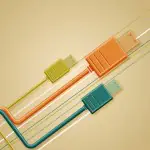
Super fast USB 3.0 and colossal SSD seems to be like a perfect marriage, with the two clearly complementing each other.
The SuperSpeed USB 3.0, as the name suggests, aims to be much faster than its predecessors, the Hi-Speed USB 2.0. With a signaling rate of 5 Gbps, usb.org claims a 10x performance boost over Hi-Speed. As I had mentioned in my previous post on SSD, the capacity of flash NAND based SSDs is on the rise. Few hundreds of giga bytes have now become standard capacities. As this type of storage reaches the enterprise world, the struggle for capacity increase will continue, and in the near future, we will have SSDs with terra byte capacities.
Now, even as SSD is a great improvement over traditional storage media, and enables massive storage spaces, without the fast speeds of data transfer, the large amount of storage would be severely restricted. To get a sense of the enormity of this problem, consider this: Based on a back-of-the-envelope calculation, USB 2.0 will take approximately 73 minutes to read 250 GB of data whereas USB 3.0 will take 7.5 minutes (not considering any types of latencies). So, combining USB 3.0 and SSD together will give us an almost perfect combination that includes a large capacity source (or a sink) and a very fast channel to move data in and out of it.
A close analysis of the specifications brings out 5 primary reasons that make USB 3.0 so fast –
- Physically, USB 3.0 implements 2 additional twisted signal pairs than USB 2.0 for carrying data.
- At a protocol level, SuperSpeed implements a dual-simplex unicast bus for concurrent bi-directional operations. Earlier versions of USB used the slow, half-duplex broadcast bus.
- Data Bursting in USB 3.0 allows the end points to send / receive data packets with no time wastage for handshakes. Though error prone, this gives greater efficiency when data is transferred in burst mode.
- USB 3.0 has introduced streaming capabilities for bulk type of transfers. This allows multiple streams (between 1 and 65533 in number) to be established over the same pipe. This gives a much greater bandwidth for data transfer.
- SuperSpeed USB 3.0 does not work on a serial transaction model like USB 2.0, where the host has to wait for an acknowledgment of a transaction before initiating a new transaction. Instead, USB 3.0 uses a sort of split transaction model, which allows multiple transactions at the same time. This kind of parallel processing results in improved response time.
The SuperSpeed USB 3.0 specification has surely set the stage for USB to be an ideal channel for data transfer from SSD. However, the real picture will emerge as USB 3.0 gets absorbed into the main stream by year 2011 and the way it stands up to competitive technologies like SATA and PCI Express.





